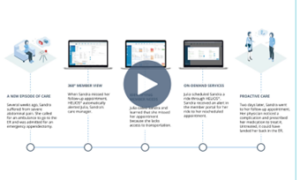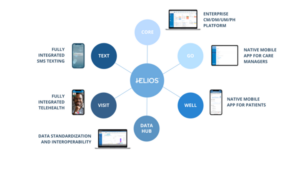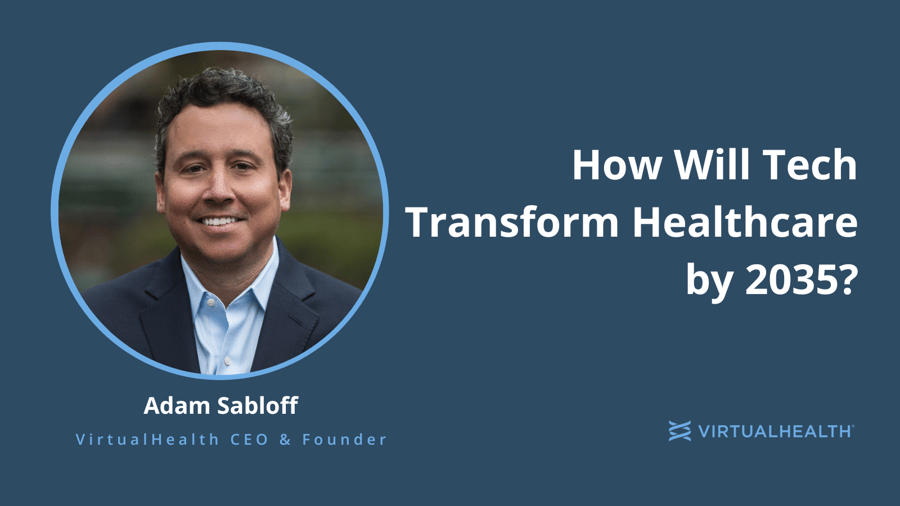Four ways technology supported by artificial intelligence (AI) and the internet of things (IoT) is creating a connected, consumer-driven health industry that enables greater health equity and overall care
Sustainability. Transparency. A paradigm shift from reactive acute care to proactive preventive care.
These goals are driving big changes in the healthcare industry. They’re part of what drive us at VirtualHealth. Thanks to an evolving health technology landscape and accomplishments in the AI and IoT fields, we’re poised to make significant progress on them – and effect transformative benefits for patients, providers, and payers.
H2: Key Benefits of a Transformed Healthcare Industry
In this future healthcare landscape, a connected ecosystem exists in which payers, providers, community resources and patients and their families are intimately connected. Data is shared. Care is personalized. Health providers are efficient. And health payers support and engage members.
When this healthcare ecosystem exists, the following (and more) are possible.
Payers can drive:
- Optimized health organization resource management
- Reductions in operational and overhead costs
- Happier, healthier, engaged members
- Efforts to address health inequities and social determinants of health
Providers can enable:
- Patient-provider connected care management
- Expedited care management processes so staff can spend more time caring for patients
- Relief from burnout and lower turnover among healthcare staff
- Care that’s accessible, transparent, effective, and affordable
Patients can expect:
- A consumer-driven experience marked by empowerment, choice, and efficiency
- Better health outcomes as a result of better collaboration and information sharing between all stakeholders involved in their care
- Personalized care and care management
- To better understand their health and how to advocate and improve it
Here are four exciting technology-driven ways healthcare is transforming to make these benefits a reality for all by 2035.
H2: 1. Enabling Consumer-driven Healthcare
Patients are consumers – and call it the Netflix effect, but today’s consumers are used to a seamless, personalized customer experience and expect the same from their healthcare. This can be especially challenging in an industry where the consumer and the customer are different stakeholders.
In healthcare, it’s not only about good customer service. A consumer-like patient experience, including more time with providers and care managers to forge authentic connections, can result in higher engagement, more trust, and better outcomes.
Forward-thinking health providers are already using tech to reimagine a patient experience that prioritizes efficiency and choice. Virtual visits, targeted outreach via preferred channels, and personalized care plans based on insights from artificial intelligence (AI) are some examples.
Remote patient monitoring devices, such as fall pendants, wearable heart rate monitors, and others, are another way to empower patients in their own healthcare. These devices have been shown to drive engagement and help clinicians make real-time adjustments for more successful outcomes.
[ADD IN HELIOS + EDEFICS PLUG]
How tech will get it done:
Providing a consumer-like healthcare experience depends on comprehensive patient data (clinical, social, economic, behavioral, socio-economic, remote, etc.) that’s readily available so staff can tailor care plans. Patient data needs to flow into a centralized platform that generates a single view accessible in just a few clicks. Telemedicine capabilities and multiple in-platform communication options (email, text) are key, as well.
H2: 2. Applying AI to Predictive Healthcare
Predictive healthcare using AI is already transforming care, enabling a shift from reactive to proactive. AI in healthcare provides some incredible benefits that result in better outcomes for patients and higher job satisfaction for staff. It can:
- Help clinicians and care managers predict when people are at higher risk for chronic conditions
- Support faster, more accurate decision-making
- Guide safer, more efficient transitions of care through data insights into changing conditions and automated updates to all care team members
- Streamline workflows and serve automated alerts and reminders
- Automatically flag at-risk patients for behavioral health or high-risk diseases
How tech will get it done:
Software with AI-powered algorithms gives clinicians immediate insight into a patient’s health and likely future developments. And AI-supported automation speeds processes and reduces administrative tasks so care teams can spend more time delivering hands-on care.
H2: 3. Building a Connected Healthcare Ecosystem
High-quality care depends on a partnership with experts and resources both inside and outside the walls of healthcare to create an ecosystem that connects all the dots of a patient’s health. (Learn about some of the partners in the HELIOS ecosystem).
That means building a digital ecosystem that includes integrations with:
- Leaders in health education, so care managers can easily send the latest resources
- National compliance guidelines so UM teams can quickly comply with best practices
- Community organizations that provide services like transportation, medication delivery, childcare, and financial assistance – when care managers can easily connect members with resources to address social determinants of health (SDOH), outcomes improve
This is essential for better addressing SDOH and health inequity for underserved and underprivileged communities and populations who may need more support for overall health, complex conditions, or access to health-related social resources.
This is also why a closed-loop ecosystem will be key. If community programs and care management teams can communicate back and forth, it’ll enable organizations to better understand (1) how to help these populations, (2) what resources are available and being utilized, and (3) how to better leverage alternative care delivery methods such as virtual video visits.
How tech will get it done:
A platform that seamlessly integrates key outside players into its processes around communication, data, and workflows is critical. Addressing SDOH (in a closed loop, both referring the services and ensuring those services are delivered to a member) should be a routine part of care management and clinical care delivery in the future, requiring a platform that connects with and reports on the utilization of community resources.
See below for how HELIOS helps care teams address SDOH.

4. Expanding Data Access and System Interoperability
Many organizations still rely on data that is months old and doesn’t flow across care teams – it lives in scattered silos that don’t “talk” to each other. Solving data interoperability is paramount for the future.
To future-proof care delivery, health organizations need a tech-based strategy to integrate real-time and historical data into a member’s profile. They need to connect data from separate organizations, a variety of quality metrics, and disparate point solutions.
It’s also important to incorporate digital health and some of the valuable tools adopted during the pandemic that have become critical in the overall delivery of care model. Without that, we are just creating new silos and an even more fragmented ecosystem.
Data interoperability is something that HELIOS is already helping many organizations solve for but continuing to address this on a larger scale is still one of our core goals. The healthcare industry won’t work in the future without solving data interoperability and removing silos.
How tech will get us there:
Software that provides one-stop data translation and transformation in the background is key. On the front end, users need an intuitive, simple experience that lets them put that data into action.

Bottom Line: Innovation and Connection Are Essential for Patients, Payers, Community Resources and Providers
If healthcare organizations can innovate to put these four drivers of change into play, it’s possible to envision a future in which:
- Payers can prioritize care more efficiently, providing the right treatment to the right people at the right time.
- Providers can spend more time with patients and less time on administration, driving better outcomes and better job satisfaction for staff.
- Patients will experience more personalized, efficient care and a higher quality of life.
- And valuable community resources will be readily available when and where members need them most.
Looking for a medical management platform that can help you start delivering care like it’s 2035 now and still evolve with you over time? here to talk more about what you need to look for when choosing a care management solution.

